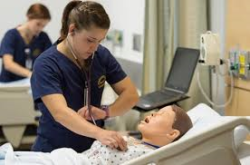
Alumni, do you remember when you were in nursing school? Simulation may have included role-playing, case studies, CD-ROM simulations, task-trainers, or simply starting IVs on one another and injecting oranges. Today, the use of simulation in schools of nursing and hospitals has grown to new heights. Advances in available simulators have created a multitude of opportunities for nursing students to learn and practice nursing skills in a realistic, safe environment.
Over the past eight years, Cedarville University School of Nursing has been blessed with several moderate fidelity manikins and a high fidelity patient simulator. Under the direction of Connie Ford and Karen Callan, simulation scenarios were developed for use in all levels across our nursing program. This development of simulation has continued to grow with our Simulation Task Force members representing the various clinical nursing courses through our undergrad and graduate programs. In the freshman and sophomore courses, students have an opportunity to utilize our moderate fidelity manikins to practice skills, including physical assessment, in a “clinical setting” – bringing to life content learned in the classroom. As students progress into the junior and senior courses, high fidelity patient simulators are used to give students an opportunity to “be the nurse” in a variety of settings including labor and delivery, mental health, pediatrics and medical-surgical. Yes, students can experience everything from delivering a baby to acting quickly in response to a medical emergency!
Simulation has opened the doors to greatly enhancing student learning and expanding clinical learning opportunities. As schools of nursing continue to find student clinical placements a challenge, moderate and high fidelity simulation has been used to fill this gap. Boards of nursing are starting to allow schools of nursing to substitute quality moderate and high fidelity simulation for clinical experiences. This is already a possibility in the state of Ohio for obstetrics, immediate newborn, and pediatric care. In preparation for these expanded possibilities, the School of Nursing participated in an assessment of our simulation program and developed a strategic plan based on industry standards for continued development and delivery of simulation. This is an exciting time in nursing education, and we welcome you to visit our simulation center to see for yourself what the excitement is all about!
Posted in: B.S.N., M.S.N., Simulation

















